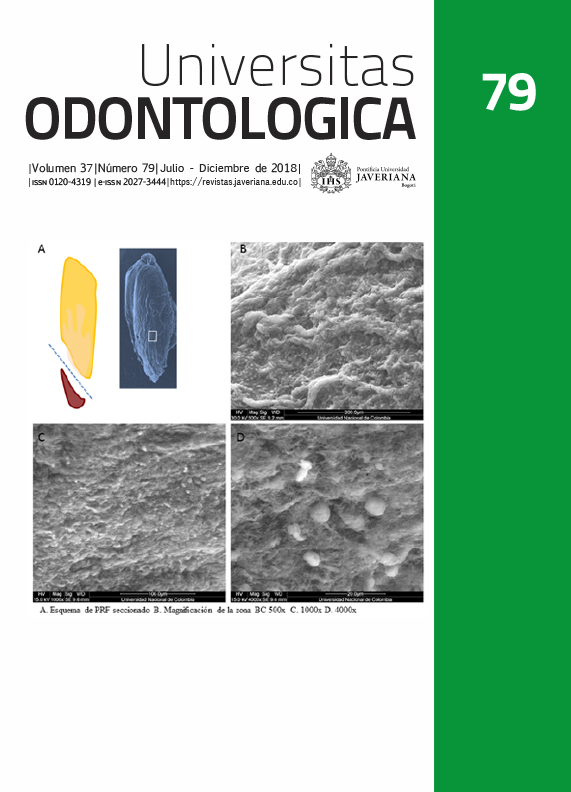Resumen
Antecedentes: El síndrome de Sjögren es una enfermedad autoinmune que empieza a manifestarse hacia los 45 años de edad y cuya incidencia aumenta con la edad. La sintomatología en la cavidad oral se caracteriza por boca seca o xerostomía. Gran cantidad de pacientes que la padecen son portadores de prótesis totales debido a la pérdida dental en edades avanzadas. Objetivo: Describir el caso de un paciente con síndrome de Sjögren a quien se le elaboró una prótesis con reservorio salival para disminuir síntomas orales. Métodos: Se realizaron ensayos de laboratorio para elaborar los reservorios buscando resistencia estructural de la prótesis; facilidad de colocación y retiro de las tapas de los reservorios para permitir la limpieza de los depósitos; estética y que contuvieran la mayor cantidad posible de saliva artificial. Los diseños se probaron en el paciente. Resultados: Después de realizar ensayos de prueba de la prótesis en ambos maxilares, el paciente comentó sobre la facilidad de retiro de las tapas, ausencia de nauseas, fonética normal, higiene adecuada, comodidad, solución parcial al problema de xerostomía y duración aproximada de tres horas una vez llenos los reservorios. Conclusión: Los prototipos finales proporcionaron mejores condiciones de los reservorios y aumentaron la cantidad de saliva. Se recomienda realizar estudios clínicos controlados para confirmar los hallazgos de este caso.
Vitali C, Bombardieri S, Moutsopoulos HM, et al. Preliminary criteria for the classification of Sjögren’s Syndrome. Results of a prospective concerted action supported the European Community. Arthritis Rheumatism. 1993; 36(3): 340-8.
Shiboski SC, Shiboski CH, Criswell LA, et al. American College of Rheumatology classification criteria for Sjögren’s Syndrome: A data-driven, expert consensus approach in the Sjögren’s International Collaborative Clinical Alliance Cohort. Arthritis Care Res. 2012; 64(4): 475-87.
Wolff S, Ofer M, Raviv, et al. The flow rate of whole and submandibular/sublingual gland saliva in patients receiving replacement complete dentures. J Oral Rehab. 2004; 340-3.
Närhi TO, Meurman JH, Ainamo A. Xerostomia and hyposalivation: causes, consequences and treatment in the elderly. Drugs Aging. 1999; 15: 103-16.
Greenspan. Xerostomia: diagnosis and management. Oncol. 1996; 10: 7-11.
Gótrickl S, Akerman D, Ericson, et al. oral Pilocarpine for treatment of opioid-induced oral dryness in healthy adults. J Dent Res. 2004; 83(5): 393-7.
Dawidson B. Angmar-Mánsson M, Blom, et al. Sensory stimulation (acupuncture) increases the release of vasoactive intestinal polypeptide in the saliva of xerostomia sufferers. Neuropeptides. 1998; 32(6): 543-8.
Davies AN. A comparison of artificial saliva and chewing gum in the management of xerostomia in patients with advances cancer. Palliat Med. 2000; (14): 197-203.
Ilzarbe LM, Ilazarbe LM Jr, Villar D. Piercing canalizado, microirrigadores CIQ e implante hueco transfixivo para tratamiento de la xerostomía grave. Gaceta Dental: Industria y Profesiones. 2006; (169): 112-32.
Vergo JT, Kadish P. Dentures as artificial saliva reservoirs in the irradiated edentulous cancer patient with xerostomia: A pilot study. Oral Surg. 1981; 51(3): 229-33.
Vissink A, Gravenmade EJ, Panders AK, et al. Artificial saliva reservoirs. J Prosthet Dent. 1984 Nov; 52: 710-5.
Toljanic JA, Zucuskie TG. Use of a palatal reservoir in denture patients with xerostomia J Prosthet Dent. 1984; 52: 540-4.
Vissink, MC Huisman, EJ Gravenmade. Construction of an artificial saliva reservoir in an existing maxillary denture. J Prosthet Dent. 1986; 56: 70-4.
Sinclair GF, Frost PM, Walter JD. New design for an artificial saliva reservoir for the mandibular complete denture. J Prosthetic Dent. 1996; 75: 276-80.
Frost PM, Gardner RM, Price AR et al. A preliminary assessment of intra-oral lubricating systems for dry mouth patients. Gerodontol. 1997; 14(1): 54-8.
Mendoza AR, Tomlinson MJ. The split denture: a new technique for artificial saliva reservoirs in mandibular dentures, Aust Dent J. 2003; 48: 190-4.
Esta revista científica se encuentra registrada bajo la licencia Creative Commons Reconocimiento 4.0 Internacional. Por lo tanto, esta obra se puede reproducir, distribuir y comunicar públicamente en formato digital, siempre que se reconozca el nombre de los autores y a la Pontificia Universidad Javeriana. Se permite citar, adaptar, transformar, autoarchivar, republicar y crear a partir del material, para cualquier finalidad (incluso comercial), siempre que se reconozca adecuadamente la autoría, se proporcione un enlace a la obra original y se indique si se han realizado cambios. La Pontificia Universidad Javeriana no retiene los derechos sobre las obras publicadas y los contenidos son responsabilidad exclusiva de los autores, quienes conservan sus derechos morales, intelectuales, de privacidad y publicidad.
El aval sobre la intervención de la obra (revisión, corrección de estilo, traducción, diagramación) y su posterior divulgación se otorga mediante una licencia de uso y no a través de una cesión de derechos, lo que representa que la revista y la Pontificia Universidad Javeriana se eximen de cualquier responsabilidad que se pueda derivar de una mala práctica ética por parte de los autores. En consecuencia de la protección brindada por la licencia de uso, la revista no se encuentra en la obligación de publicar retractaciones o modificar la información ya publicada, a no ser que la errata surja del proceso de gestión editorial. La publicación de contenidos en esta revista no representa regalías para los contribuyentes.



